Patricia Domínguez
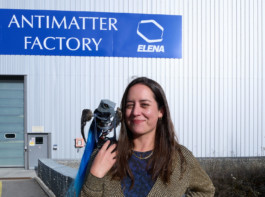
© Marina Cavazza
Patricia Domínguez (she/her) lives and works in Puchuncaví, Chile.
Working across media — including watercolor, ceramics, sculptural assemblages, and video installations — Patricia Domínguez creates shrine-like worlds that draw on myths, symbols, rituals, and healing practices. Her visual vocabulary glides between plant life, consumer goods, corporate wellness aesthetics, and the digital sphere, blending artistic imagination with experimental ethnobotanical research. By examining the intersection of historical and economic forces with the bodies and the environment, often referencing her own family history, she seeks to trace the spiritual connections between living beings in a world increasingly dominated by capitalist exploitation.
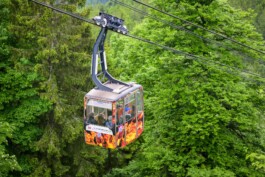
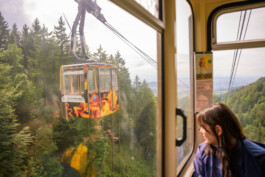
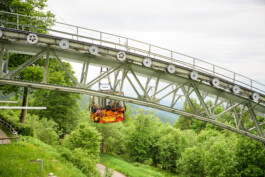
Patricia Domínguez, Un ojo que vuela en la selva, 2025, Installation view, Schauinslandbahn, Photo: Marc Doradlzillo, © Biennale für Freiburg 3
Patricia Domínguez, Un ojo que vuela en la selva, 2025, Installation view, Schauinslandbahn, Photo: Marc Doradlzillo, © Biennale für Freiburg 3
Patricia Domínguez, Un ojo que vuela en la selva, 2025, Installation view, Schauinslandbahn, Photo: Marc Doradlzillo, © Biennale für Freiburg 3
Un ojo que vuela en la selva
2025
Intervention: digital drawings
Variable dimensions
Three gondolas of the Schauinsland cable car have been visually transformed with images of a toucan, a jaguar, and a snake—animals native to the South American tropics and now carriers of stories marked by fire, loss, and resilience. The intervention draws from the artist’s time at a wildlife refuge in Roboré, Bolivia, during the catastrophic fires of 2019 in the Chiquitanía and Amazon regions, where she assisted in caring for injured animals, including a blind toucan that became central to this work.
"Un ojo que vuela en la selva" (An eye that flies in the rain forest) honors the lives of countless animals lost to wildfires, monoculture, drought, and extractive industries. The three creatures—now rendered on the exterior of a popular cable car attraction—stand in as witnesses to ecological breakdown, but also as emblems of adaptation and survival.
As the cable cars glide over the dense green of the Freiburg forest, they draw an unexpected connection between two vastly different yet deeply entangled topographies: one lush and better preserved, the other scorched and vanishing. This contrast prompts reflection on how we assign value to certain landscapes—and how the aesthetic appeal of preserved environments can sometimes make us forget that elsewhere, nature is being irreversibly destroyed through deliberate interference and the consequences of the climate crisis.
Titel
Location
Information
VeranstaltungEN mit XXX
Event
Location
Date
In Cooperation with
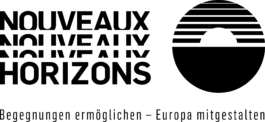
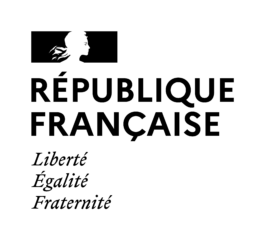

Patricia Domínguez

© Marina Cavazza
Patricia Domínguez (she/her) lives and works in Puchuncaví, Chile.
Working across media — including watercolor, ceramics, sculptural assemblages, and video installations — Patricia Domínguez creates shrine-like worlds that draw on myths, symbols, rituals, and healing practices. Her visual vocabulary glides between plant life, consumer goods, corporate wellness aesthetics, and the digital sphere, blending artistic imagination with experimental ethnobotanical research. By examining the intersection of historical and economic forces with the bodies and the environment, often referencing her own family history, she seeks to trace the spiritual connections between living beings in a world increasingly dominated by capitalist exploitation.



Patricia Domínguez, Un ojo que vuela en la selva, 2025, Installation view, Schauinslandbahn, Photo: Marc Doradlzillo, © Biennale für Freiburg 3
Patricia Domínguez, Un ojo que vuela en la selva, 2025, Installation view, Schauinslandbahn, Photo: Marc Doradlzillo, © Biennale für Freiburg 3
Patricia Domínguez, Un ojo que vuela en la selva, 2025, Installation view, Schauinslandbahn, Photo: Marc Doradlzillo, © Biennale für Freiburg 3
Un ojo que vuela en la selva
2025
Intervention: digital drawings
Variable dimensions
Three gondolas of the Schauinsland cable car have been visually transformed with images of a toucan, a jaguar, and a snake—animals native to the South American tropics and now carriers of stories marked by fire, loss, and resilience. The intervention draws from the artist’s time at a wildlife refuge in Roboré, Bolivia, during the catastrophic fires of 2019 in the Chiquitanía and Amazon regions, where she assisted in caring for injured animals, including a blind toucan that became central to this work.
"Un ojo que vuela en la selva" (An eye that flies in the rain forest) honors the lives of countless animals lost to wildfires, monoculture, drought, and extractive industries. The three creatures—now rendered on the exterior of a popular cable car attraction—stand in as witnesses to ecological breakdown, but also as emblems of adaptation and survival.
As the cable cars glide over the dense green of the Freiburg forest, they draw an unexpected connection between two vastly different yet deeply entangled topographies: one lush and better preserved, the other scorched and vanishing. This contrast prompts reflection on how we assign value to certain landscapes—and how the aesthetic appeal of preserved environments can sometimes make us forget that elsewhere, nature is being irreversibly destroyed through deliberate interference and the consequences of the climate crisis.
Titel
Location
Information
VeranstaltungEN mit XXX
Event
Location
Date
In Cooperation with


